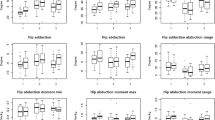Abstract
Purpose
The purpose of this study was to work out an objective and sensitive method for the early postoperative period following total knee arthroplasty (TKA) in which analysis of the gait parameters is possible and also to investigate the influence of different surgical approaches for TKA on the gait during stepping in the first three months of the postoperative period.
Methods
Three groups of patients: age-matched healthy elderly patients as a control group, patients operated upon by the conventional technique and finally by the minimally invasive technique combined with computer-assisted navigation. All three groups included ten patients. The motions of knee, shoulder and pelvis were measured by ZEBRIS ultrasound-based system preoperatively plus six and 12 weeks postoperatively. From the joint motion, the variability of cadence, and the variability of knee joint motion and that of pelvis and shoulder girdle was determined.
Results
Osteoarthritis (OA) of the knee joint and TKA using both operation techniques significantly influenced the variability of stepping parameters compared to the controls. In the early postoperative period a significant difference was detected between the two groups of the operated patients in all parameters.
Conclusion
Our data prove that our method seems appropriate to provide objective measurement of the gait in the early postoperative period. The variability of motion of the patient groups approaches that of the healthy control group steadily, but does not reach them.




Similar content being viewed by others
References
Bejek Z, Paroczai R, Szendroi M, Kiss RM (2011) Gait analysis following TKA: comparison of conventional technique, computer-assisted navigation and minimally invasive technique combined with computer-assisted navigation. Knee Surg Sports Traumatol Arthrosc 19:285–291
Boeer J, Mueller O, Krauss I, Haupt G, Axmann D, Horstman T (2010) Effect of a sensory-motor exercise program for older adults with osteoarthritis or prosthesis of the hip using measurements made by Posturomed oscillatory platform. J Geriatr Phys Ther 33:10–15
Dubost V, Kressig RW, Gonthier R, Herrmann FR, Aminian K, Najafi B, Beauchet O (2006) Relationship between dual task related changes in stride velocity and stride time variability in healthy older adults. Hum Mov Sci 25:372–382
England SA, Granata KP (2007) The influence of gait speed on local dynamic stability of walking. Gait Posture 27:172–178
Fuchs S, Floren M, Skwara A, Tibesku CO (2002) Quantitative gait analysis in unconstrained total knee arthroplasty patients. Int J Rehabil Res 25:65–70
Georgoulis AD, Moraiti C, Ristanis S, Stergiou N (2007) A novel approach to measure variability in the anterior cruciate ligament deficient knee during walking: the use of approximate entropy in orthopaedics. J Clin Monit Comput 20:11–18
Hausdorff JM (2007) Gait dynamics, fractals and falls: finding meaning in the stride-to-stride fluctuations of human walking. Hum Mov Sci 26:555–589
Hausdorff JM, Rios DA, Edelberg HK (2001) Gait variability and fall risk in community-living older adults: a 1-year prospective study. Arch Phys Med Rehabil 82:1050–1056
Hausdorff JM (2005) Gait variability. Methods, modeling and meaning. J Neuroeng Rehabil 20:19
Hubley-Kozey CL, Deluzio KJ, Landry SC, McNutt JS, Stanish WD (2006) Neuromuscular alterations during walking in persons with moderate knee osteoarthritis. J Electromyogr Kinesiol 16:365–378
Kellgren JH, Lawrence JS (1957) Radiological assessment of osteoarthrosis. Ann Rheum Dis 16:494–502
Kiss RM (2009) Parameters of kinaesthesis during gaits derived from an ultrasound-based measuring system. In: Brebbia ED (ed) Modelling in medicine and biology VIII. WIT Press, Southampton, pp 171–180
Kiss RM (2010) A járás sebességének és a csípőízületi arthrosis fokának hatása a járás változékonyságára. (In English: Effect of speed of gait and severity of coxarthrosis on the variability of gait parameters). Biomech Hung 2:37–46
Kiss RM (2011) Effect of severity of knee osteoarthritis on the variability of gait parameters. J Electromyogr Kinesiol 21:695–703
Kiss RM (2011) A new parameter for characterizing balancing ability on an unstable oscillatory. Med Eng Phys. doi:10.1016/j.medengphy.2011.04.017
Kiss RM, Bejek Z, Szendroi M (2012) Variability of gait parameters in patients with total knee arthroplasty. J Electromyogr Kinesiol 20(7):1252–1260
McClelland JA, Webster KE, Feller JA (2009) Variability of walking and other daily activities in patients with total knee replacement. Gait Posture 30:288–295
Müller O, Günther M, Krauß I, Horstman T (2004) Physical characterization of the therapeutic device Posturomed as a measuring device-Presentation of a procedure to characterize balancing ability. Biomed Tech 49:56–60, in German, Abstract in English
Newel KM, Corcos DM (1993) Issues in variability and motor control. In: Newel KM, Corcos DM (eds) Variability and motor control. Human Kinetics Publishers, Champaign, pp 1–12
Petersen MK, Andersen NT, Mogensen P, Voight M, Søballe K (2011) Gait analysis after total hip replacement with hip resurfacing implant or Mallory-head Exeter prosthesis: a randomised controlled trial. Int Orthop 35(5):667–674
Smith AJ, Lloyd DG, Wood DJ (2004) Pre-surgery knee joint loading pattern during walking predict the presence and severity of anterior knee pain after total knee arthroplasty. J Orthop Res 22:260–266
Smith AJ, Lloyd DG, Wood DJ (2006) A kinematic and kinetic analysis of walking after total knee arthroplasty with and without patellar resurfing. Clin Biomech 21:379
Stergiou N, Moraiti C, Glakas G, Ristanis S, Georgoulis A (2004) The effect of walking speed on the stability of the anterior cruciate ligament deficient knee. Clin Biomech 19:57–63
Yakhdani HRF, Bafgi HA, Meijer OG, Bruijn SM, van den Dikkenberg N, Stibbe AB, van Royen BJ, van Dieen JH (2010) Stability and variability of knee kinematics during gait in knee osteoarthritis before and after replacement surgery. Clin Biomech 25:230–236
Acknowledgments
The authors wish to express their thanks to radiologist Katalin Köllő for her assistance in the evaluation of radiographic images, and to orthopaedist Dr. Zoltán Bejek PhD for his contribution. This project is supported by the Hungarian Scientific Fund (K083650).
Author information
Authors and Affiliations
Corresponding author
Rights and permissions
About this article
Cite this article
Pethes, Á., Kiss, R.M. & Szendrői, M. Variability of gait in the early postoperative period of total knee arthroplasty with different surgical technique. International Orthopaedics (SICOT) 38, 517–523 (2014). https://doi.org/10.1007/s00264-013-2115-y
Received:
Accepted:
Published:
Issue Date:
DOI: https://doi.org/10.1007/s00264-013-2115-y




